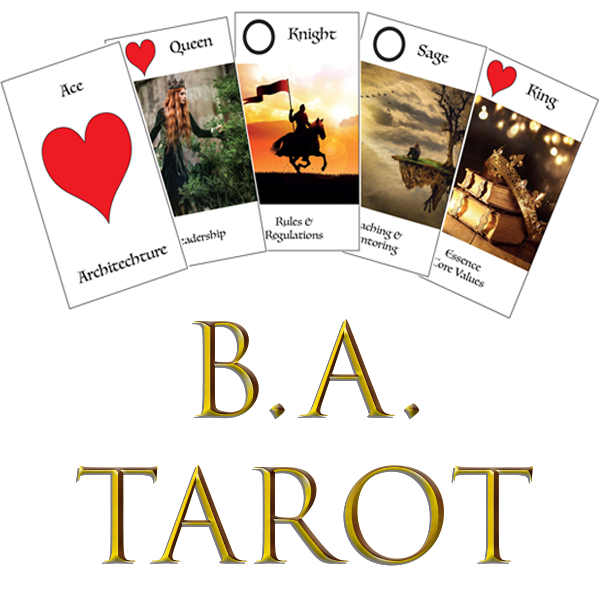New BA Tarot 4.0!
The V4.0 version is fundamentally the same as the V3.0 and MAD about CRM Version in principal.
However we have updated it with new imagery and cards to support elicitaltion.
ALSO we have them all on Miro for remote use.

The fundamentals of the cards are the same as the original but I have added more detail to the reverse of the cards and listed them more fully here for clarity . This is particularly useful during one to one elicitation and identifying strategic priorities.
 NEW BA TAROT V4.0!
NEW BA TAROT V4.0!
This new version is a combination of the V3 cards but with some changes to bring them in line with the Personal and the Product Tarot. New artworks for consistency, 3 new cards, The solution, The journey and the Backlog – The backlog isn’t essential but I created it for the product tarot deck and thought it may be of use to consider the backlog of things that may need to be considered.
Now we have 3 sets of cards reflecting how the original 6 functions can be adapted for many situations. I would love your feedback
I Hope you like the new version – here is an overview of each card and the reverse contents.
We have all the decks on Miro so you can do workshops remotely contact me if you want to give them a try jhc[at] jhc.me – obv use the correct @ sign (this just helps slow down spam.
Hearts – Organisation (Identity & alignment)
The suit of Organisation explores how an enterprise defines itself and stays aligned. It asks: what is the organisation here to do, how does it function, and what ambitions guide it? It also examines ownership and governance, the methods chosen, the vision that inspires, and the wider context that frames its existence. Organisation is the identity of the business world — the anchor for purpose, direction, and collective effort.
Focus: purpose, structure, leadership and authority of the organisation
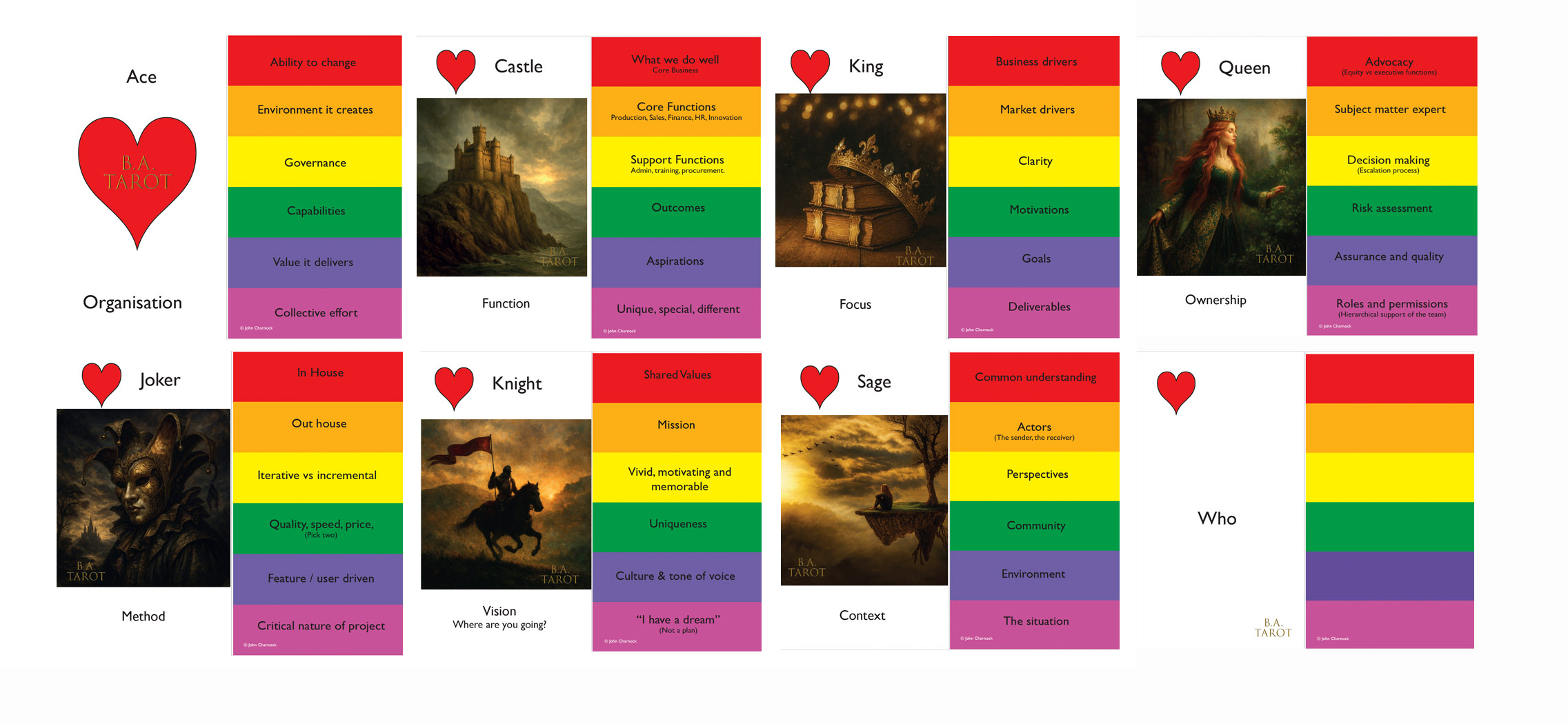
Ace – Organisation (core principle)
The Ace represents the Organisation and its Ability to Change, the organisation’s capacity to evolve and adapt. It highlights the environment the organisation creates, the governance that enables change, and the capabilities it must develop. It also points to the value delivered and the need for collective effort. Without adaptability, organisations stagnate; with it, they thrive.
Back triggers: Environment it creates, Governance and leadership, Capabilities, Value it delivers, Collective effort
Castle – Function (foundation)
The Castle symbolises Function, the foundation of what an organisation actually does. It includes the core business and functions — production, sales, finance, HR, innovation — as well as support functions like admin, training, and procurement. It also points to outcomes, aspirations, and what makes the organisation unique, special, or different. Function is the bedrock of organisational identity.
Back triggers: What we do well, Core business, Core functions, Support functions , Outcomes, Aspirations, Unique/special/different
King – Focus (ambition & authority)
The King embodies Focus, the authority to set direction. It calls attention to business and market drivers, the need for clarity, and the motivations that shape goals. It also stresses defining deliverables and maintaining alignment between ambition and execution. Focus is the force that channels energy into meaningful outcomes.
Back triggers: Business drivers, Market drivers, Clarity, Motivations, Goals, Deliverables
Queen – Ownership (relational aspect)
The Queen represents Ownership, the relational structures of accountability. It highlights advocacy, the role of subject matter experts, and clear decision-making and escalation processes. It also points to risk assessment, assurance and quality, and the distribution of roles and permissions across the team. Ownership ensures authority is matched by responsibility.
Back triggers: Advocacy , Subject matter expert, Decision making , Risk assessment, Assurance and quality, Roles and permissions .
Joker – Method (wildcard/uncertainty)
The Joker reveals Method, the wildcard of how the organisation chooses to deliver. It highlights whether work is done in-house or outsourced, whether approaches are iterative or incremental, and how trade-offs are made between quality, speed, and price. It also asks whether delivery is feature-driven or user-driven, and how the criticality of the project affects choices. Methods can empower or undermine depending on how they are applied.
Back triggers: In-house, Out-house, Iterative vs incremental, Quality/speed/price (pick two), Feature-driven vs user-driven, Critical nature of project
Knight – Vision (method/movement)
The Knight reflects Vision in motion, the living expression of organisational purpose. It emphasises shared values and a mission that is vivid, motivating, and memorable. It also highlights uniqueness, the shaping of culture and tone of voice, and the inspirational power of a vision that feels like a dream, not just a plan.
Back triggers: Shared values, Mission, Vivid/motivating/memorable, Uniqueness, Culture & tone of voice, “I have a dream” (not a plan)
Sage – Context (strategic perspective)
The Sage represents Context, the wider setting that frames organisational choices. It calls attention to building a common understanding, mapping the actors, and appreciating different perspectives. It also includes the role of community, awareness of the environment, and the grounding of decisions in the current situation. Context ensures strategy and action are rooted in reality.
Back triggers: Common understanding, Actors , Perspectives, Community, Environment, The situation
Circles – Knowledge (Intelligence & Learning)
The suit of Knowledge explores how organisations acquire, manage, and apply information. It covers the use of prior and community knowledge, flows of intelligence, external insights, and the role of expertise. It also examines the risks of ignorance, the frameworks of law and governance, and the importance of training to sustain capability. Knowledge ensures that decision-making is grounded in evidence and learning, not assumption.
Focus: knowledge, intelligence, rules, and training
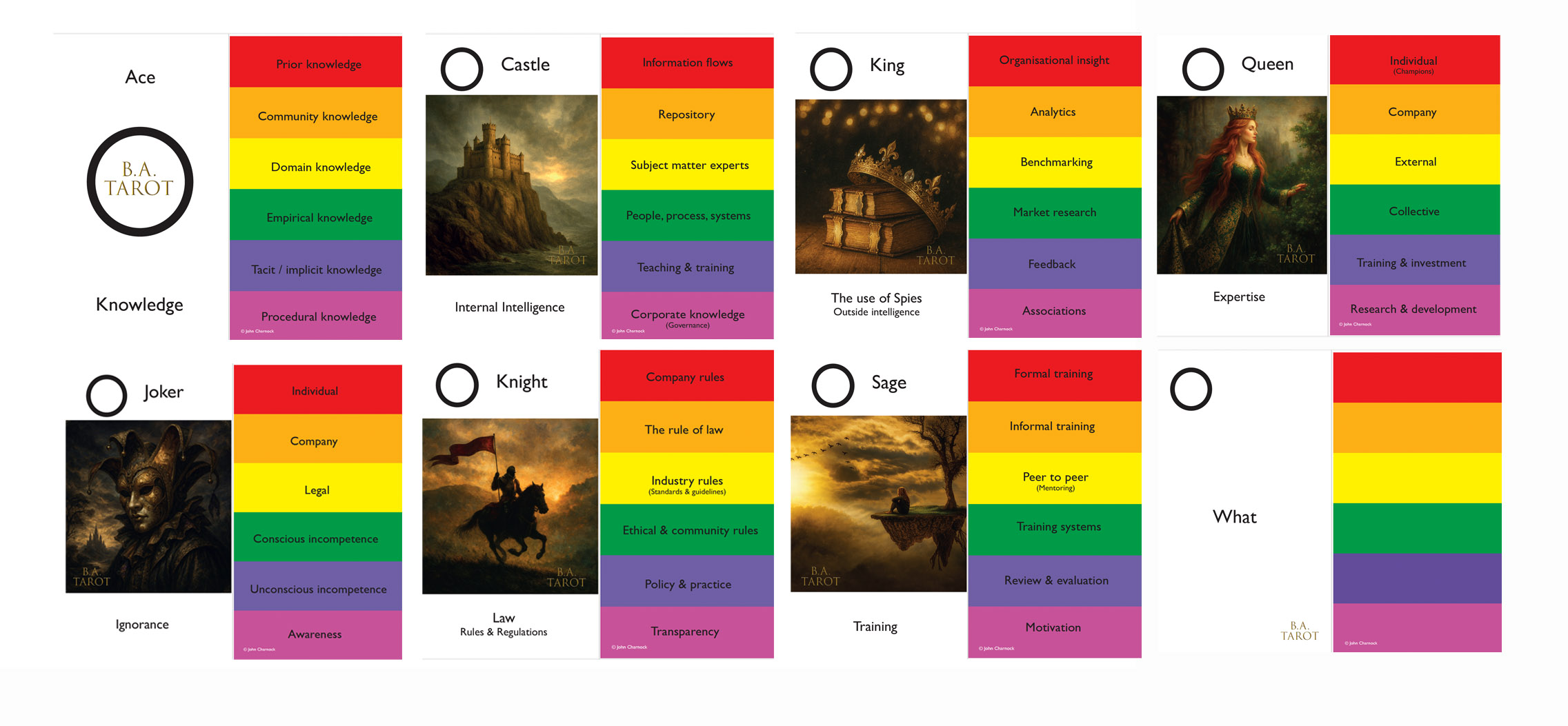
Ace – Knowledge (core principle)
The Ace represents Knowledge, the essential base of information. It highlights prior knowledge, community knowledge, and domain knowledge, as well as the value of empirical and tacit knowledge. It also stresses the importance of procedural knowledge in shaping consistent practice. Knowledge is the cornerstone of analysis.
Back triggers: Prior knowledge, Community knowledge, Domain knowledge, Empirical knowledge, Tacit/implicit knowledge, Procedural knowledge
Castle – Internal Intelligence (foundation)
The Castle symbolises Internal Intelligence, the flows of knowledge that sustain the organisation. It includes information repositories, subject matter experts, and the combined insight of people, processes, and systems. It also highlights the role of teaching and training and corporate knowledge governance in maintaining quality.
Back triggers: Information flows, Repository, Subject matter experts, People/process/systems, Teaching & training, Corporate knowledge (governance)
King – The Use of Spies (ambition & authority)
The King embodies The Use of Spies, the ambition to extend knowledge beyond internal boundaries. It stresses building organisational insight through analytics, benchmarking, market research, feedback, and associations. This card reminds organisations that authority comes from awareness and understanding of teh landscape that the organisation operates within — both inside and out.
Back triggers: Organisational insight, Analytics, Benchmarking, Market research, Feedback, Associations
Queen – Expertise (relational aspect)
The Queen represents Expertise, the relational dimension of shared knowledge. It highlights individual champions, company expertise, and the role of external advisors. It also includes collective knowledge, training and investment, and the power of research and development. Expertise makes knowledge practical and relational.
Back triggers: Individual (champions), Company, External, Collective, Training & investment, Research & development
Joker – Ignorance (wildcard/uncertainty)
The Joker exposes Ignorance, the blind spots and gaps in knowledge. It highlights risks at the individual and company level, as well as legal limitations. It also calls attention to conscious and unconscious incompetence and the importance of raising awareness. Ignorance is the uncertainty that can undermine a business and recognising that you may be ignorant of some aspects enables the organisation to root out more insights.
Back triggers: Individual, Company, Legal, Conscious incompetence, Unconscious incompetence, Awareness
Knight – Law (method/movement)
The Knight embodies Law, the frameworks that codify knowledge into rules and expectations. It points to company rules, the rule of law, and industry standards. It also stresses the importance of ethical and community rules, policies and practices, and transparency. Law is how knowledge becomes enforceable and actionable.
Back triggers: Company rules, The rule of law, Industry rules (standards & guidelines), Ethical & community rules, Policy & practice, Transparency
Sage – Training (strategic perspective)
The Sage represents Training, the strategic investment in developing knowledge over time. It includes formal and informal training, peer-to-peer mentoring, and structured training systems. It also highlights review and evaluation and the role of motivation in sustaining learning. Training ensures knowledge remains fresh and relevant.
Back triggers: Formal training, Informal training, Peer-to-peer mentoring, Training systems, Review & evaluation, Motivation
Triangles – Resources & Constraints
The suit of Resources explores what an organisation must draw upon to function and grow. It covers the essential needs required for survival, the tangible and intangible assets that define capability, the stakeholders that influence or constrain, the protections that safeguard resilience, and the products that represent the outcomes of resource use. Resources determine what is possible, where limits lie, and how value is sustained over time.
Focus: resources, needs, protection, and resilience
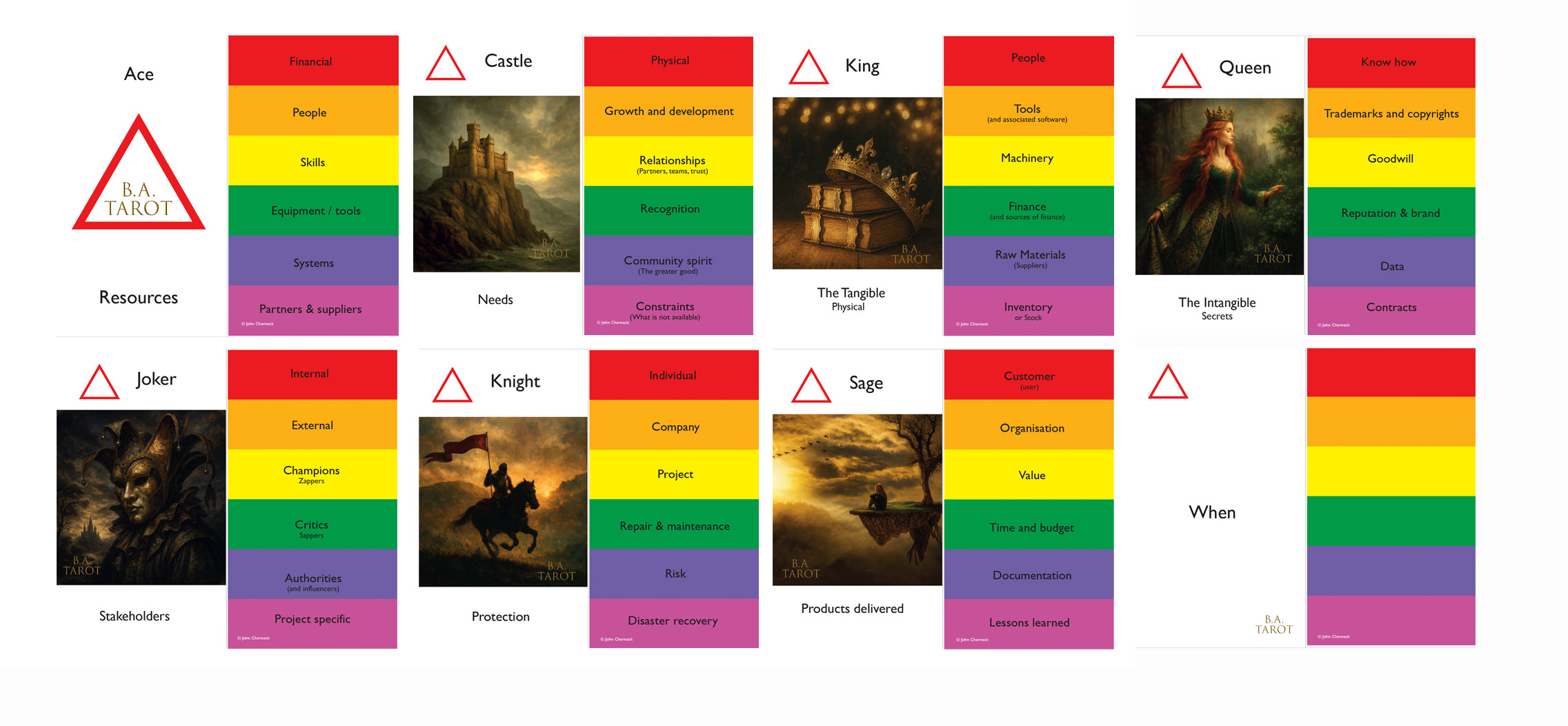
Ace – Resources (core principle)
The Ace represents Resources, the fundamental base that powers the organisation. It asks: what finance, people, knowledge, time, and technology are available, and how much trust and goodwill can be called upon? Resources are the fuel that enable ambition, strategy, and delivery. Without clarity on resources, plans remain abstract.
Back triggers: Finance, People, Knowledge, Time, Tools & technology, Trust & goodwill
Castle – Needs (foundation)
The Castle symbolises Needs, the non-negotiables the organisation must secure to survive and thrive. These include funding, skilled people, reliable data and information, and adequate time and capacity. It also extends to tools, technology, and physical space. Needs are the foundation on which all ambition rests — without them, execution is impossible.
Back triggers: Funding, People & skills, Time & capacity, Data & information, Tools & technology, Space & facilities
King – Tangible Assets (ambition & authority)
The King embodies Tangible Assets, the measurable resources that set the scale of ambition. It highlights cash, property, facilities, infrastructure, and equipment, as well as inventories that underpin production. Tangible assets give authority and weight to ambition — they determine the scope of what can be delivered in practice.
Back triggers: Cash & credit, Physical assets, Equipment, Facilities, Inventory, Infrastructure
Queen – Intangible Assets (relational aspect)
The Queen represents Intangible Assets, the unseen but powerful enablers of success. These include reputation, brand, trust, and influence, as well as relationships, agreements, and loyalty. Though fragile and hard to quantify, these assets are often more decisive than money — they shape credibility, resilience, and the ability to gain support.
Back triggers: Reputation, Brand, Influence, Trust, Relationships, Agreements, Loyalty
Joker – Stakeholders (wildcard/uncertainty)
The Joker reveals Stakeholders, the human and political factor in resources. Stakeholders — whether customers, regulators, suppliers, sponsors, communities, or boards — can be champions or obstacles. They bring energy, support, and legitimacy, but they can also create friction, demands, or resistance. Stakeholders are the wildcard that can make or break resourcing.
Back triggers: Customers & users, Partners & suppliers, Regulators, Internal sponsors, Community & public, Boards & auditors
Knight – Protection (method/movement)
The Knight embodies Protection, the active defence of resources. It stresses risk management, security, compliance, continuity, and recovery planning, alongside practical measures like insurance and contingency. Protection ensures resources are preserved and safeguarded so that momentum is not lost when challenges arise. Protection also appertains to people how you train, encourage, retain and keep them motivated – people maintenance !
Back triggers: Risk management, Security & privacy, Compliance & assurance, Business continuity, Incident response & recovery, Insurance & contingency
Sage – Products (strategic perspective)
The Sage represents Products, the visible outcomes of resource use and investment. Products and services are resources in their own right — they require portfolio management, lifecycle care, quality and warranty, and ongoing support. They also carry technical debt and demand retirement or renewal. Products embody the value delivered and the promises sustained, shaping the long-term legacy of the organisation.
Back triggers: Portfolio & SKUs/services, Lifecycle (discover–deliver–operate–retire), Quality & warranty, Support & maintenance, Technical debt, Sunsetting & replacement
Spades – Conduct (behaviour & activities)
The suit of Conduct explores how an organisation behaves — what it does, how it acts, and the methods it uses to maintain momentum. It includes the promises made and kept, the authenticity shown through consistency, and the motivations that fuel activity. Conduct also covers communication, style, and method, while recognising that over time, actions accumulate into the story and reputation of the organisation. This suit is about moving from intent to sustained action.
Focus: momentum, behaviour, and consistency of delivery
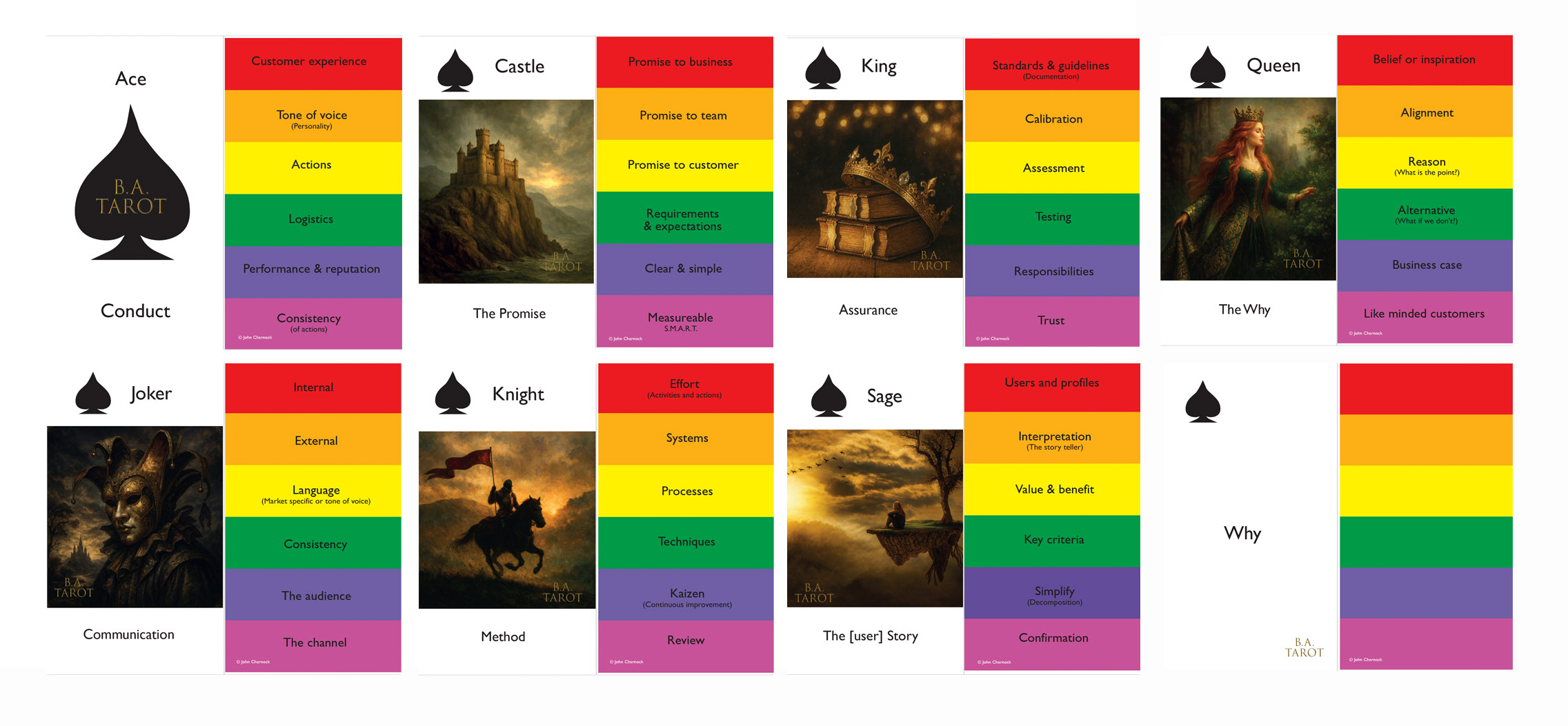
Ace – Behaviour (core principle)
The Ace represents Behaviour, the core expression of organisational conduct. It covers activities, routines, and discipline, and the visible effort and practice that sustain delivery. Behaviour defines how the organisation is experienced both internally and externally.
Back triggers: Activities, Routines, Discipline, Effort, Actions, Practice
Castle – Promise (foundation)
The Castle symbolises Promise, the commitments that underlie conduct. These include duties, the promises made to others, and the commitments made to self. It also calls attention to the weight of broken promises. The organisation’s promises shape trust — they form the foundation of credibility.
Back triggers: Commitments, Duties, Promise to others, Promise to self, Broken promises
King – Authenticity (ambition & authority)
The King embodies Authenticity, the authority of being genuine in action. It stresses consistency, stability, and reliability, alongside the importance of endurance. It also points to trustworthiness and living by honour and values. Authenticity is the ambition to be credible through conduct, not just words.
Back triggers: Consistency, Stability, Reliability, Endurance, Trustworthiness, Honour values
Queen – Motivation (relational aspect)
The Queen represents Motivation, the driver of conduct. It highlights purpose, drive, and intent, as well as the passion and energy behind delivery. It reminds us that conduct isn’t only about what is done, but why it is done — motivation gives meaning to activity.
Back triggers: Motivation, Purpose, Drive, Intent, Passion, Outcomes
Joker – Communication (wildcard/uncertainty)
The Joker reveals Communication, the wildcard in conduct. It stresses the role of expression, tone, body language, and the need to consider audience and channel. It also highlights the importance of listening. Poor communication can undermine even the best conduct, while clear communication multiplies its impact.
Back triggers: Expression, Tone, Body language, Audience, Listening, Channel
Knight – Method (method/movement)
The Knight embodies Method, the practices and techniques that bring conduct to life. It includes processes, tools, and experiences, as well as techniques and continuous improvement (Kaizen). It also highlights style and reflection. Method is how behaviour becomes structured, efficient, and repeatable.
Back triggers: Processes, Tools & experiences, Techniques, Kaizen/continuous improvement, Style, Reflection
Sage – Story (strategic perspective)
The Sage represents Story, the narrative built from conduct over time. It highlights how identity, meaning, and lessons learned are woven into the organisation’s journey. It also points to how the story reflects growth and serves as a guide for future conduct.
Back triggers: Identity, Narrative, Meaning, Lessons, Journey, Growth
Clubs – Cunning (Strategy & Direction)
The suit of Strategy explores how an organisation plans and navigates. It considers the measures used to track progress, the approaches chosen, and the way time and priorities are managed. It also highlights the importance of scope, tactics, and change as a constant factor. Strategy is about aligning vision with reality — balancing ambition and capacity through clever, adaptable choices.
Focus: planning, priorities, tactics, and adaptability
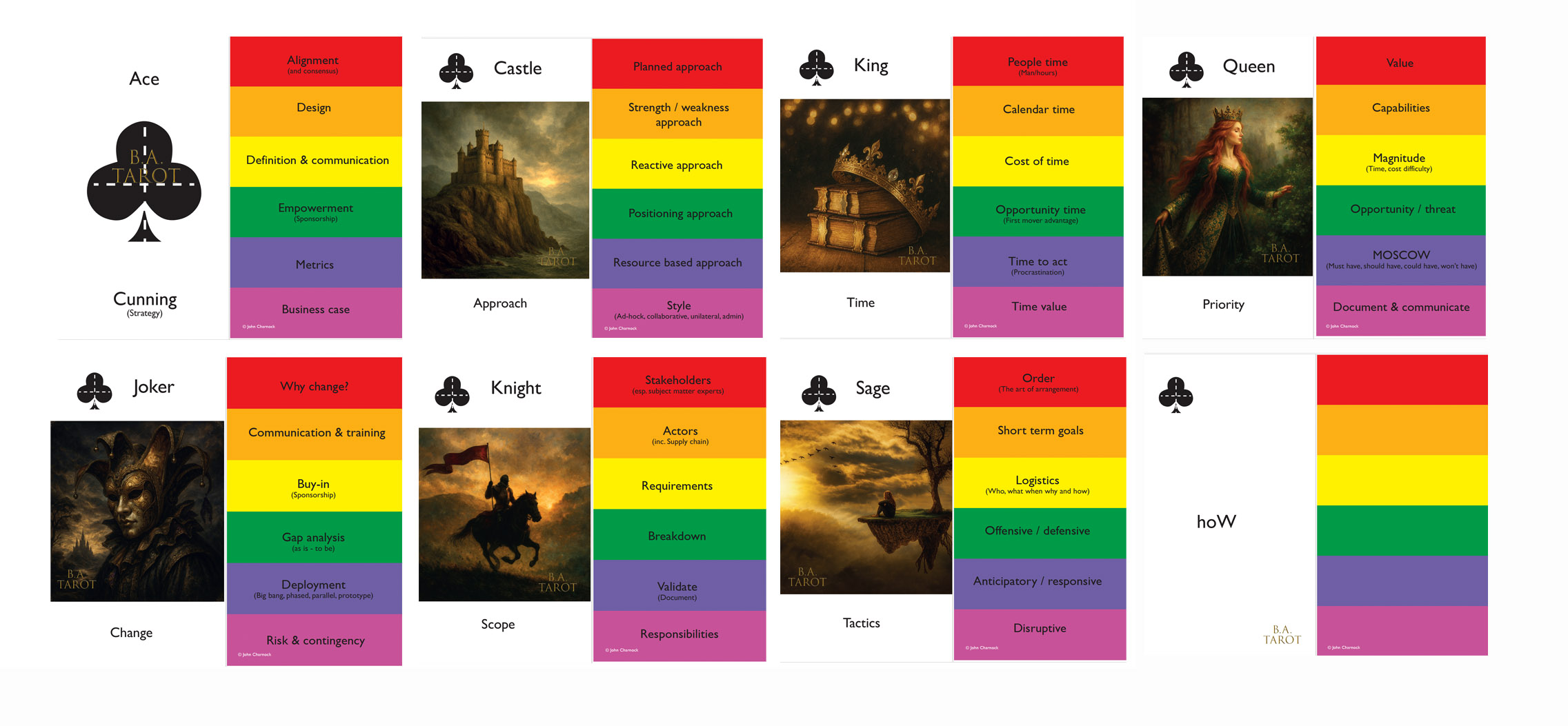
Castle – Approach (foundation)
The Castle symbolises Approach, the foundation of how strategy is planned. It includes frameworks and planning styles — from analytical to improvisational, from agile to waterfall, In house to out house — and the style of execution, whether collaborative or unilateral. The approach chosen creates the foundation for tactics and outcomes.
Back triggers: Planning framework, Analytical, Improvisational, Dreamer, Realist, Style (ad-hoc, collaborative, unilateral)
King – Time (ambition & authority)
The King embodies Time, the authority of when and how strategy unfolds. It highlights priorities, deadlines, opportunity windows, and cost of delay. It also calls attention to the timing of action and balancing time demands. Mastering time gives strategy its edge.
Back triggers: Priorities, Deadlines & seasons, Cost of time, Opportunity time, Time to act, Balancing time
Queen – Priority (relational aspect)
The Queen represents Priority, the discipline of choosing what matters most. It involves assessing value and trade-offs, making tough choices, and balancing opportunity with risk. It also includes clarifying essentials and understanding dependencies. Priorities define where attention and resources go.
Back triggers: Value, Trade-offs, Choices, Opportunity/risk, Essentials, Dependencies
Joker – Change (wildcard/uncertainty)
The Joker reveals Change, the uncertainty that tests any strategy. It highlights the reasons why change happens or what happens if you dont change ? The need for adaptability, and the potential for renewal. It also reflects uncertainty, pivots, and resilience in the face of risk. Change can disrupt — but it can also transform.
Back triggers: Why change?, Adaptability, Renewal, Uncertainty, Pivot, Risk & resilience
Knight – Scope (method/movement)
The Knight embodies Scope, the boundaries that frame execution. It includes assessing capacity and capability, recognising risks of overload, and maintaining focus on vision. It also calls for simplification and consideration of scaling. Scope ensures ambition stays achievable.
Back triggers: Boundaries, Capacity/capability, Overload, Focus on vision, Simplify, Scale
Sage – Tactics (strategic perspective)
The Sage represents Tactics, the craft of executing strategy. It highlights clever moves, order and logistics, innovation, and creativity. It also explores shortcuts and the balance of being disruptive vs. constructive. Tactics are the practical art of turning plans into impact.
Back triggers: Order, Clever moves, Logistics, Innovation & creativity, Shortcuts, Disruptive vs constructive
Diamonds – Winning (Betterment & Outcomes)
The suit of Winning explores what success means to an organisation and how it achieves competitive advanyage. It looks at unique strengths, talents, and advantages, and how these are turned into outcomes. Winning also considers how success is measured, the processes and practices that sustain it, and the balance needed for long-term sustainability. It highlights the motivations and efficiencies that drive performance, and the techniques that elevate achievement into mastery. This suit is about both tangible outcomes and lasting fulfilment.
Focus: achievement, measurement, sustainability, and mastery
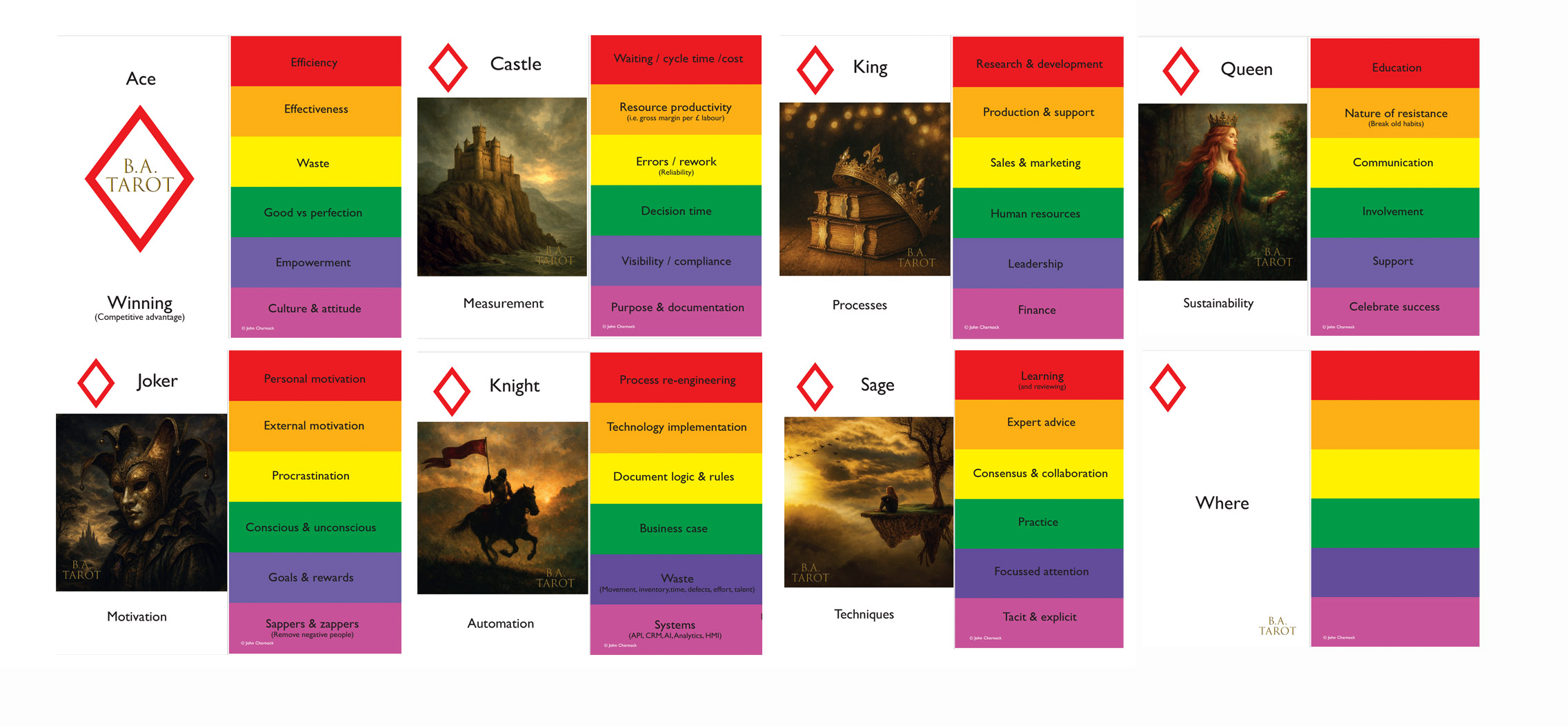
Ace – Winning (core principle)
The Ace represents Winning, the pursuit of achievement. It highlights unique strengths, talents, and differentiators, as well as attitude, self-esteem, and aspirations. Winning is about knowing what makes the organisation strong and how it applies that strength to succeed.
Back triggers: Unique strengths, Talent & potential, Edge/differentiator, Self-esteem, Good vs perfection, Attitude
Castle – Measurement (foundation)
The Castle symbolises Measurement, the foundation for judging success. It includes feedback, reflection, and evaluation, as well as clarifying what success looks like. It also stresses outcomes and recognition of purpose. Measurement turns achievement into something visible and accountable.
Back triggers: Feedback, Reflection, Errors/evaluation, What success looks like, Outcomes, Purpose & recognition
King – Processes (ambition & authority)
The King embodies Processes, the structures and routines that sustain winning. It points to habits, practice, training, consistency, and momentum, as well as reliance on systems and tools. Processes make performance repeatable and give authority to ambition.
Back triggers: Habits & routines, Practice, Training, Consistency & momentum, Systems & tools, Discipline
Queen – Sustainability (relational aspect)
The Queen represents Sustainability, the relational balance needed to maintain success. It calls attention to health, wellbeing, balance, rest, and renewal, alongside the importance of longevity and resilience. Sustainability ensures that winning is not a short-term sprint but a long-term achievement.
Back triggers: Balance, Health & wellbeing, Rest, Renewal, Longevity, Resilience
Joker – Motivation (wildcard/uncertainty)
The Joker exposes Motivation, the unpredictable energy behind outcomes. It can be driven by passion, goals, recognition, and incentives, but can also be undermined by procrastination. Motivation is the wildcard that determines whether potential becomes progress.
Back triggers: Drive, Passion, Procrastination, Goals & incentives, Recognition, Energy
Knight – Automation (method/movement)
The Knight embodies Automation, the practices that make achievement efficient. It includes shortcuts, routines, and hacks, alongside tools, technology, and AI. It also highlights reducing waste and making strategic investments in technologies like AI and IT but also professional advice and support. Automation enables efficiency so effort can focus on higher-value work.
Back triggers: Efficiency, Shortcuts/hacks, Routine & habits, Wasted time, Investment, Tools (AI, tech, advice)
Sage – Techniques (strategic perspective)
The Sage represents Techniques, the mastery of practice that elevates achievement. It stresses learning, expert advice, and collaboration, as well as focused attention, disciplined practice, and mastery. Techniques ensure that winning is not luck, but the result of deliberate craft.
Back triggers: Learning, Expert advice, Collaboration, Focused attention, Practices, Mastery
Auxiliary Cards
The Auxiliary Cards sit outside the six core suits. They provide higher-order perspectives, lenses, and guiding principles that connect across all aspects of business analysis. These cards capture enduring questions, align value, define solutions, and remind us that every organisation is on a journey.
Focus: overarching perspectives and guiding frameworks
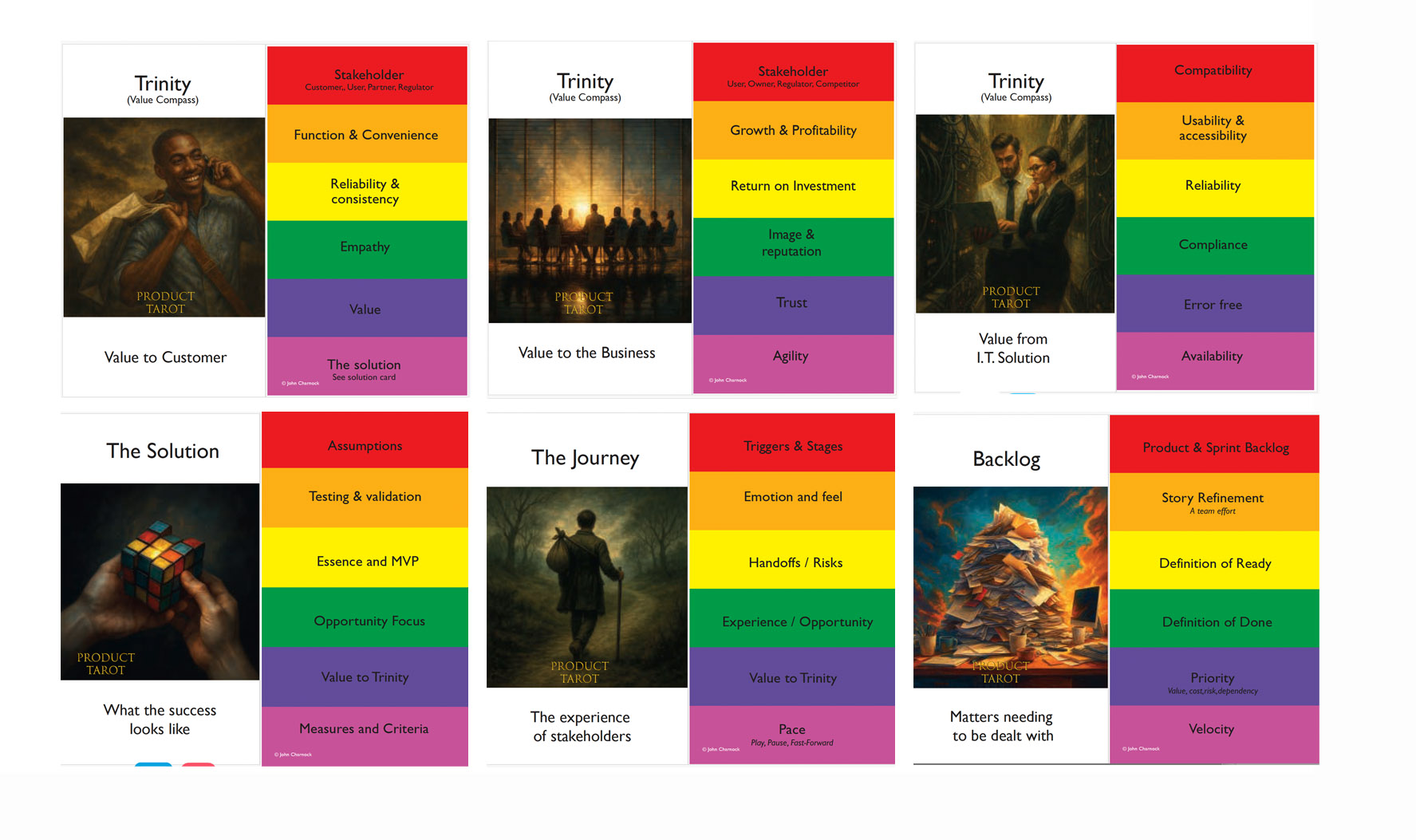
The 6Ws – Foundational Questions
The 6Ws are the root of inquiry — the questions that drive clarity. They encourage analysts to interrogate any problem space systematically.
Back triggers: Who, What, Where, When, Why, How
The Trinity – Value Drivers
The Trinity represents the balance of perspectives that drive value. It asks us to consider needs and impacts from the customer view, the business view, and the IT/solution view. Together, these form the holy trinity of alignment and ensure solutions create shared value.
Back triggers: Customer, Business, IT Solution
The Solution – Outcomes in Focus
The Solution represents the tangible outcome of analysis. It reminds us that solutions must emerge from the value drivers — customer, business, and IT — and be tested against feasibility and alignment. It asks what is possible, what delivers value, and what is sustainable.
Back triggers: Customer needs, Business goals, IT enablers, Feasibility, Value alignment, Sustainability
The Journey – Change Over Time
The Journey represents the arc of transformation. It reminds us that every organisation evolves — through milestones, transitions, achievements, and setbacks. The journey card encourages reflection on where you are, where you’ve been, and where you’re going, reinforcing that change is continuous.
Back triggers: Milestones, Transitions, Achievements, Setbacks, Current state, Future vision
The Backlog – Things that need to be done
The backlog has been borrowed from the Product owner deck – for more info check out the product owner cards – But I put a card here because I considered it may be useful when looking at prioritisation and considering the scale of the backlog – Use it or nos as you feel appropriate.
